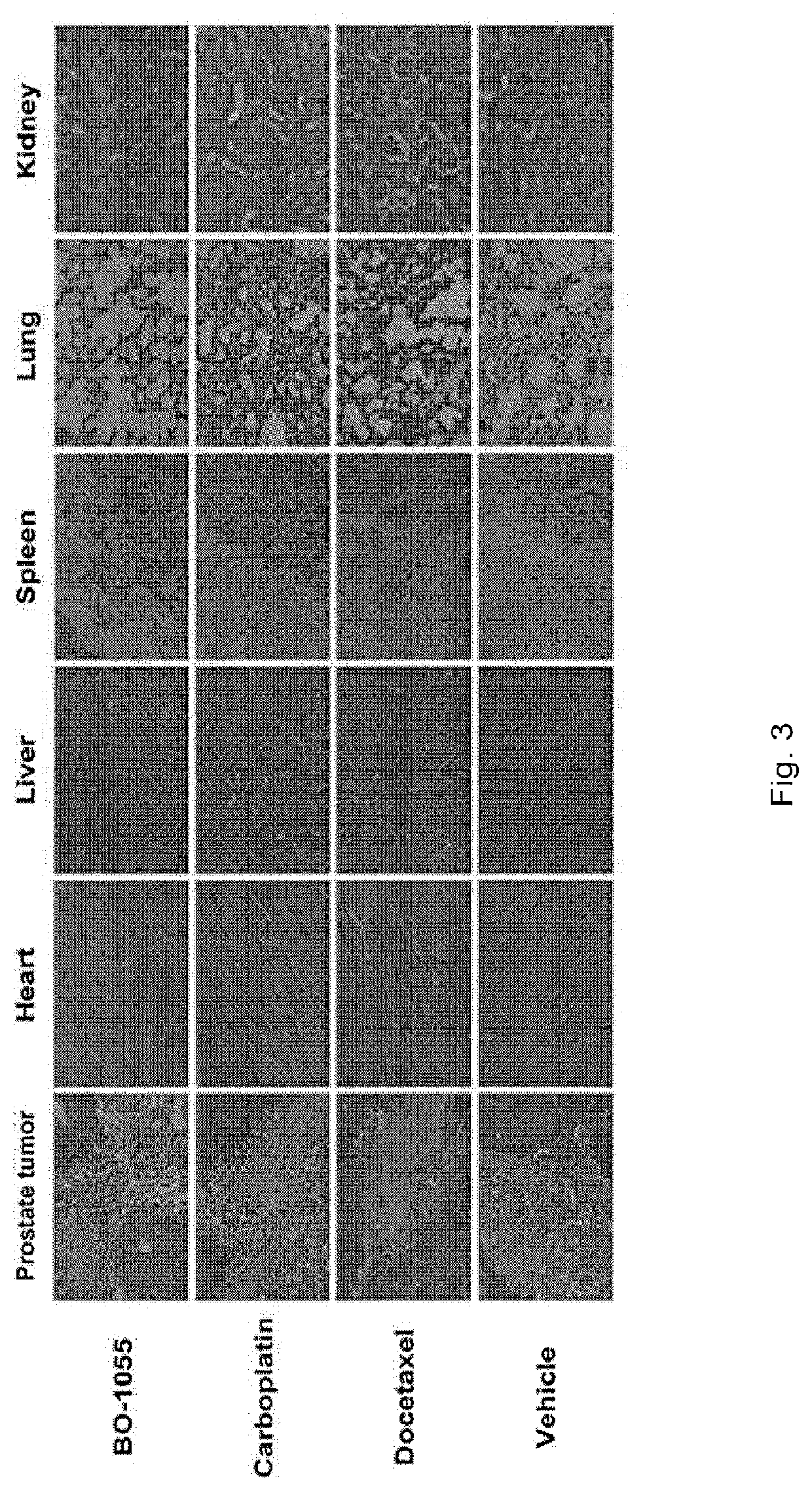Use of ureidomustine (BO-1055) in cancer treatment
a cancer treatment and ureidomustine technology, applied in the field of ureidomustine (), can solve the problems of self-defeating process of aggressive therapy, unintended “survival of the fittest” response, acquired resistance and therapeutic failure, etc., and achieve the effect of reducing the number of cancer cells and not resulting in significant toxicities
- Summary
- Abstract
- Description
- Claims
- Application Information
AI Technical Summary
Benefits of technology
Problems solved by technology
Method used
Image
Examples
example 1
Cytotoxicity of Ureidomustine
Ureidomustine (BO-1055) Toxicity Determined in a Panel of Human and Murine Benign Tissue Types.
[0096]To determine the toxicity of BO-1055 on non-malignant tissues, the inventors utilized the MTT and alamar blue assays (Hamid et al. 2004) to measure IC50 values on 29 different normal human, murine or primate cell and tissue types (Table 1). BO-1055 was evaluated on all 29 normal tissues. Of these, 24 / 29 were highly resistant (IC50≥10.0-≥100.0 μm) and 5 were moderately resistant (IC50 8.80-9.48 μM). The latter group included fallopian tube epithelium, fetal bone marrow stroma, cord blood CD34+ hematopoietic stem / progenitor cells in serum replacement medium, CAFC week 2 progenitors and CAFC week 5 hematopoietic stem cells.
[0097]
TABLE 1Cytotoxicity of water soluble ureidomustine (BO-1055) on various human,murine and primate normal tissues in vitro*. 72 hr cytotoxicity (IC50, μM).Normal tissueTissue Type105516HBE SV40+Bronchial epithelium≥10.0BCI-NSI hTERTBro...
example 2
Toxicity of Alkylating Drugs Carboplatin, Cisplatin, Temozolomide, Melphalan, Bendamustine and Cyclophosphamide (Active Metabolite 4-HC) Determined in a Panel of Human and Murine Normal Tissue Types.
[0104]The panel of 19 benign tissue types that was used to determine the cytotoxicity of BO-compounds was also used to screen for cytotoxicity of six commonly used alkylating drugs, carboplatin, cisplatin, temozolomide, melphalan, bendamustine and 4-HC (the active metabolite of cyclophosphamide) (Table 2).
[0105]Seven tissues were screened with carboplatin one was moderately sensitive (IC50 of 1.70 μM). and 6 / 7 were highly resistant (IC50 of 32.8->1000 μM). 12 / 14 lines were resistant to cisplatin (IC50 of ≥20.0->100 μM) but 2 / 3 bronchial lines was sensitive (IC50 3.60-4.10 μM) as were cord blood hematopoietic progenitors (IC50 1.80 μM).
[0106]Temozolomide was evaluated on 7 tissues with 5 tissues highly drug resistant (IC50 20.0->100.0 μM) with one, the murine MS5 stromal line, showing wea...
example 3
The Resistance of Normal Benign Murine Cells and Human Cord Blood CD34+ Cells, Hematopoietic Progenitor Cells (HPC) and Hematopoietic Stem Cells (HSC) to Ureidomustine (BO-1055) Cytotoxicity.
[0111]FIG. 1 shows the effect of ureidomustine on the proliferation of human CB CD34+HPC determined by wk 2 CAFC assay, and HSCs determined by the wk 5 CAFC assay (IC50 7.5-8.2 μM). There was variation in the sensitivity among independent CB samples tested with a mean IC50 of 9.20 μM for wk2 CAFC (progenitor cells) and 9.10 μM for wk5 CAFC (HSC) (Table 2).
[0112]FIG. 2 demonstrates effect of ureidomustine on the proliferation of various normal cell types compared to a human acute myeloid leukemia (AML) cell line.
[0113]Normal cells: Human cord blood CD34+ cells (hu-CB-CD34+). This subpopulation is enriched for hematopoietic progenitor cells (HPC ˜30%) and hematopoietic stem cells (HSC ˜5%). BM-derived endothelial cells (BMEC). Human mesenchymal stromal cells (MSC), murine MS-5 (BM-MSC) and murine ...
PUM
| Property | Measurement | Unit |
|---|---|---|
| time | aaaaa | aaaaa |
| volume | aaaaa | aaaaa |
| time | aaaaa | aaaaa |
Abstract
Description
Claims
Application Information
 Login to View More
Login to View More - R&D
- Intellectual Property
- Life Sciences
- Materials
- Tech Scout
- Unparalleled Data Quality
- Higher Quality Content
- 60% Fewer Hallucinations
Browse by: Latest US Patents, China's latest patents, Technical Efficacy Thesaurus, Application Domain, Technology Topic, Popular Technical Reports.
© 2025 PatSnap. All rights reserved.Legal|Privacy policy|Modern Slavery Act Transparency Statement|Sitemap|About US| Contact US: help@patsnap.com



